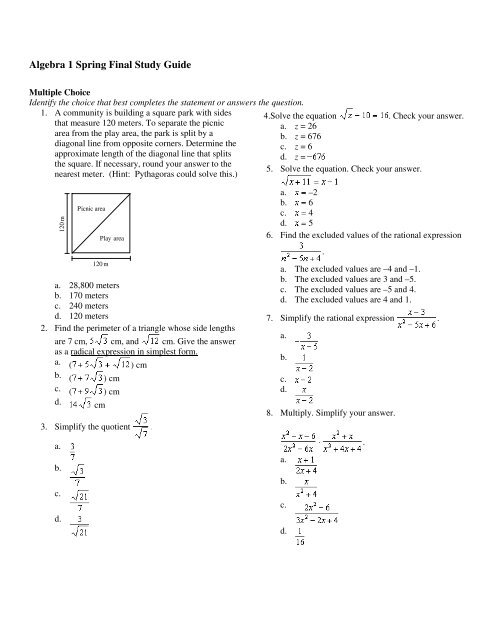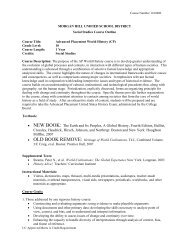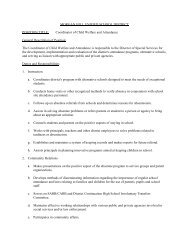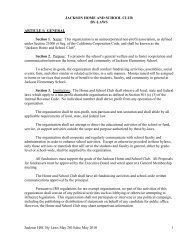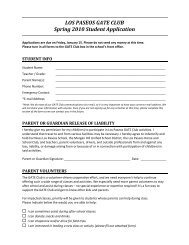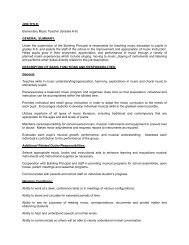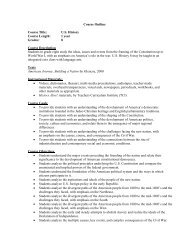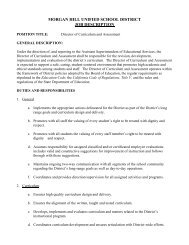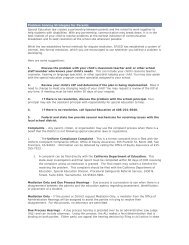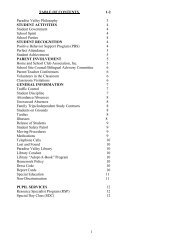You also want an ePaper? Increase the reach of your titles
YUMPU automatically turns print PDFs into web optimized ePapers that Google loves.
<strong>Algebra</strong> 1 <strong>Spring</strong> <strong>Final</strong> <strong>Study</strong> <strong>Guide</strong><br />
Multiple Choice<br />
Identify the choice that best completes the statement or answers the question.<br />
1. A community is building a square park with sides<br />
that measure 120 meters. To separate the picnic<br />
area from the play area, the park is split by a<br />
diagonal line from opposite corners. Determine the<br />
approximate length of the diagonal line that splits<br />
the square. If necessary, round your answer to the<br />
nearest meter. (Hint: Pythagoras could solve this.)<br />
4.Solve the equation<br />
. Check your answer.<br />
a. z = 26<br />
b. z = 676<br />
c. z = 6<br />
d. z =<br />
5. Solve the equation. Check your answer.<br />
120 m<br />
Picnic area<br />
Play area<br />
120 m<br />
a. 28,800 meters<br />
b. 170 meters<br />
c. 240 meters<br />
d. 120 meters<br />
2. Find the perimeter of a triangle whose side lengths<br />
are 7 cm, cm, and cm. Give the answer<br />
as a radical expression in simplest form.<br />
a. ( ) cm<br />
b. ( ) cm<br />
c. ( ) cm<br />
d. cm<br />
3. Simplify the quotient<br />
a.<br />
b.<br />
c.<br />
d.<br />
a. –2<br />
b. 6<br />
c. 4<br />
d. 5<br />
6. Find the excluded values of the rational expression<br />
.<br />
a. The excluded values are –4 and –1.<br />
b. The excluded values are 3 and –5.<br />
c. The excluded values are –5 and 4.<br />
d. The excluded values are 4 and 1.<br />
7. Simplify the rational expression .<br />
a.<br />
b.<br />
c.<br />
d.<br />
8. Multiply. Simplify your answer.<br />
a.<br />
b.<br />
c.<br />
d.<br />
.
9. Subtract and simplify. Find the excluded values.<br />
a.<br />
b.<br />
c.<br />
d.<br />
;<br />
; and<br />
; , and<br />
; and<br />
10. Ting can mow a lawn in 4 hours. Her boss, Renald,<br />
can mow the same lawn in 3 hours. How long will<br />
it take them to mow the lawn if they work together<br />
a. hours<br />
b. hours<br />
c. 1 hour<br />
d. hours<br />
11. A chemist has 600 milliliters of a solution that is<br />
half acid. She needs a solution that is 70% acid.<br />
How many milliliters of acid she should add<br />
a. 300 mL<br />
b. 400 mL<br />
c. 500 mL<br />
d. 600 mL<br />
12. A bullet train travels 30 miles per hour faster than a<br />
passenger train, and it takes the bullet train 3 hours<br />
less time to travel 400 miles. How long does it<br />
takes the passenger train to make the trip.<br />
a. 4 hours<br />
b. 6 hours<br />
c. 8 hours<br />
d. 10 hours<br />
13. Solve .<br />
a. a = –29<br />
b. a = 29<br />
c. a = 15<br />
d. a = –15<br />
14. Solve .<br />
a.<br />
b.<br />
c.<br />
d.<br />
15. Solve . Check your answer.<br />
a. x = 6<br />
b. x = 8<br />
c. x = 5<br />
d. x = 7<br />
16. Solve .<br />
a.<br />
b.<br />
c.<br />
d.<br />
17. Solve .<br />
a. = 4<br />
b. = –11<br />
c. = –1<br />
d. = 5<br />
18. Solve the proportion .<br />
a. x = 36<br />
b. x = 26<br />
c. x = 0.03<br />
d. x = 25<br />
19.Solve the inequality<br />
a. p ≤ –8<br />
–10<br />
–8<br />
b. p ≥ –8<br />
–10<br />
c. p ≤ 8<br />
–10<br />
d. p ≥ 8<br />
–10<br />
–8<br />
–8<br />
–8<br />
–6<br />
–6<br />
–6<br />
–6<br />
–4<br />
–4<br />
–4<br />
–4<br />
–2<br />
–2<br />
–2<br />
–2<br />
≥ 4 and graph the solutions.<br />
0 2 4 6 8 10<br />
0 2 4 6 8 10<br />
0 2 4 6 8 10<br />
0 2 4 6 8 10<br />
20. Mrs. Williams is deciding between two field trips<br />
for her class. The Science Center charges $135 plus<br />
$3 per student. The Dino Discovery Museum<br />
simply charges $6 per student. For how many<br />
students will the Science Center charge less than<br />
the Dino Discovery Museum<br />
a. 132 or more students<br />
b. 132 or fewer students<br />
c. More than 45 students<br />
d. Fewer than 45 students
21. Solve and graph the solutions of the compound<br />
inequality .<br />
a. AND<br />
b. AND<br />
c. AND<br />
d. AND<br />
22. Solve the inequality.<br />
0 1 2 3 4 5<br />
0 1 2 3 4 5<br />
0 1 2 3 4 5<br />
0 1 2 3 4 5<br />
a. The solution set is .<br />
b. The solution set is .<br />
c. The solution set is OR .<br />
d. The solution set is all real numbers.<br />
23. Give the domain and range of the relation.<br />
6<br />
4<br />
2<br />
y<br />
2 4 6 x<br />
a. D: 0 ≤ x ≤ 7; R: 1 ≤ y ≤ 7<br />
b. D: 1 ≤ x ≤ 6; R: 1 ≤ y ≤ 7<br />
c. D: 2 ≤ x ≤ 6; R: 4 ≤ y ≤ 7<br />
d. D: 1 ≤ x ≤ 7; R: 1 ≤ y ≤ 6<br />
24. For , find when x = –1.<br />
a. –2<br />
b. 6<br />
c. –4<br />
d. 2<br />
25. Find the x- and y-intercepts of .<br />
a. x-intercept: −11, y-intercept: 4<br />
b. x-intercept: −11, y-intercept: 3<br />
c. x-intercept: –8, y-intercept: 3<br />
d. x-intercept: –8, y-intercept: 4<br />
26.Find the slope of the line that contains and<br />
.<br />
− 11<br />
a.<br />
3<br />
c. − 3 Hint:<br />
11<br />
∆y<br />
− 3<br />
b.<br />
5<br />
d. − 5 y =<br />
3<br />
∆x<br />
d. x = 2y + 3 2<br />
27. Tell whether the slope of the line is positive,<br />
negative, zero, or undefined.<br />
y<br />
5<br />
4<br />
3<br />
2<br />
1<br />
–5 –4 –3 –2 –1<br />
–1<br />
1 2 3 4 5 x<br />
–2<br />
–3<br />
–4<br />
–5<br />
a. negative c. undefined<br />
b. positive d. zero<br />
28. Tell whether the relation is a direct variation.<br />
Explain.<br />
x –10 –9 1<br />
y 20 18 –2<br />
a. This is a direct variation, because it can be<br />
written as , where k = .<br />
b. This is not a direct variation, because it cannot<br />
be written in the form .<br />
c. This is a direct variation, because it can be<br />
written as , where .<br />
d. This is a direct variation, because it can be<br />
written as , where k = –2.<br />
29. Write the equation that describes the line with slope<br />
= 2 and y-intercept = 3 in slope-intercept form.<br />
2<br />
a. 2x + y = 3 2<br />
b. y = 3 x + 2 2<br />
c. y = 2x + 3 2
30. Write the equation that describes the line in slopeintercept<br />
form.<br />
slope = 4, point (3, –2) is on the line<br />
a. y = 4x + 14<br />
b. y = 4x – 14<br />
c. y = 4x + 10<br />
d. y = 4x – 2<br />
31. Write an equation in point-slope form for the line<br />
that has a slope of 6 and contains the point (–8, –7).<br />
a. x – 8 = 6(y – 7)<br />
b. y + 8 = 6(x + 7)<br />
c. y – 7 = 6(x – 8)<br />
d. y + 7 = 6(x + 8)<br />
32. Write an equation in slope-intercept form for the<br />
line parallel to y = 5x – 2 that passes through the<br />
point (8, –2).<br />
a. y = − 1 5 x – 2<br />
b. y = − 1 5 x – 2 5<br />
c. y = 5x + 32<br />
d. y = 5x – 42<br />
33. Tell whether the ordered pair (5, –3) is a solution of<br />
the system .<br />
a. no<br />
b. yes<br />
34. Solve by substitution. Express your<br />
answer as an ordered pair.<br />
a. ( 3, −2)<br />
b. (− 8 3 , –3)<br />
c. (− 4 3 , 1)<br />
d. (−2, 3)<br />
35. Solve by elimination. Express your<br />
answer as an ordered pair.<br />
a. (–2, –3)<br />
b. (–2, 0)<br />
c. (0, –2)<br />
d. (–8, –6)<br />
36. Solve by elimination. Express your<br />
answer as an ordered pair.<br />
a. (3, 4)<br />
b. (4, 3)<br />
c. (3, 2)<br />
d. ( 4 7 , 8 5 )<br />
37. An airplane travels 900 miles from Houston to<br />
Miami in 6 hours against the wind. On its return<br />
trip, with the wind, it takes only 5 hours. Find the<br />
rate of the airplane with no wind. Find the rate of<br />
the wind.<br />
a. The airplane flies at 155 mi/h with no wind.<br />
The rate of the wind is 135 mi/h.<br />
b. The airplane flies at 165 mi/h with no wind.<br />
The rate of the wind is 135 mi/h.<br />
c. The airplane flies at 155 mi/h with no wind.<br />
The rate of the wind is 15 mi/h.<br />
d. The airplane flies at 165 mi/h with no wind.<br />
The rate of the wind is 15 mi/h.<br />
38. The sum of the digits of a two-digit number is 12.<br />
When the digits are reversed, the new number is 18<br />
less than the original number. Find the original<br />
number. Check your answer.<br />
a. The original number is 75.<br />
b. The original number is 84.<br />
c. The original number is 57.<br />
d. The original number is 93.<br />
39. The planet Mars has an average distance from the<br />
sun of about 141,600,000 miles. Write this number<br />
in scientific notation.<br />
a. 14.16 × 10<br />
b. 1.416 × 10 7<br />
c. 1.416 × 10 8<br />
d. 0.1416 × 10<br />
40. Simplify .<br />
a.<br />
b.<br />
c.<br />
d.
41. Simplify .<br />
a.<br />
−<br />
b.<br />
−<br />
c. –<br />
d.<br />
−<br />
42. Simplify .<br />
a.<br />
b.<br />
c.<br />
d.<br />
43. Simplify the expression .<br />
a. 29<br />
b. 9<br />
c. 13<br />
d. 10<br />
44. Multiply.<br />
a.<br />
b.<br />
c.<br />
d.<br />
45. Multiply.<br />
a.<br />
b.<br />
c.<br />
d.<br />
46. Factor by grouping.<br />
a.<br />
b.<br />
c.<br />
d.<br />
47. Factor .<br />
a.<br />
b.<br />
c.<br />
d.<br />
48. Determine whether is a difference of two<br />
squares. If so, factor it. If not, explain why.<br />
a.<br />
b.<br />
c.<br />
d. Not a difference of squares because –49n 4 is<br />
not a perfect square.<br />
49. Factor completely.<br />
a.<br />
b.<br />
c.<br />
d.<br />
50. Solve the quadratic equation by<br />
factoring.<br />
a. –4 and 2<br />
b. 4 and 2<br />
c. –4 and –2<br />
d. 4 and –2<br />
51. Solve 64x 2 – 121 = 0 by using square roots.<br />
a. ± 11<br />
8<br />
b. ± 64<br />
121<br />
c. No solution<br />
d. ± 8 11<br />
52. Solve by completing the square.<br />
a. The solution is –5.<br />
b. There is no solution.<br />
c. The solutions are –1 and 5.<br />
d. The solutions are –1 and –5.<br />
53. Solve by using the Quadratic Formula.<br />
a. x = 9 or x = −1<br />
b. x = 1 or x = −9<br />
c. x = 54 or x = −46<br />
d. x = 18 or x = −2
54.Find the number of solutions of the equation<br />
by using the discriminant.<br />
a. There is one solution.<br />
b. Cannot determine the number of solutions. The<br />
discriminant can only be used for a quadratic<br />
equation, and<br />
is not a quadratic<br />
equation.<br />
c. There are no real solutions.<br />
d. There are two solutions.<br />
55. Find the domain of the square-root function<br />
a. –8<br />
b. − 9 8<br />
c. −1<br />
d. –8<br />
.<br />
56.Simplify .<br />
a. c.<br />
b. d.<br />
57.Which graph represents a function<br />
a.<br />
y<br />
c.<br />
y<br />
5<br />
5<br />
4<br />
4<br />
3<br />
3<br />
2<br />
2<br />
1<br />
1<br />
–5 –4 –3 –2 –1<br />
–1<br />
1 2 3 4 5 x<br />
–2<br />
–3<br />
–4<br />
–5<br />
–5 –4 –3 –2 –1<br />
–1<br />
1 2 3 4 5 x<br />
–2<br />
–3<br />
–4<br />
–5<br />
b.<br />
y<br />
d.<br />
y<br />
5<br />
5<br />
4<br />
4<br />
3<br />
3<br />
2<br />
2<br />
1<br />
1<br />
–5 –4 –3 –2 –1<br />
–1<br />
1 2 3 4 5 x<br />
–2<br />
–3<br />
–4<br />
–5<br />
–5 –4 –3 –2 –1<br />
–1<br />
1 2 3 4 5 x<br />
–2<br />
–3<br />
–4<br />
–5
58. The scatter plot shows the relationship between the weekly total sales ($) and the number of different rug designs a<br />
rug store has. Based on this relationship,<br />
predict what the total sales will be when<br />
the store has 110 different rug designs.<br />
50000<br />
a. $31,000<br />
b. $0<br />
c. $38,000<br />
d. $35,000<br />
Total Sales ($)<br />
40000<br />
30000<br />
20000<br />
10000<br />
20 40 60 80 100 120 140 160<br />
Number of Designs<br />
Short Answer<br />
59. Solve the inequality and graph the solutions. Then write the solutions as a compound inequality.<br />
60. Write the equation in slope-intercept 63. Graph the system of linear inequalities<br />
form. Then graph the line described by the<br />
equation.<br />
. Give two ordered pairs that are<br />
61. Solve the system by graphing.<br />
62. Graph the solutions of the linear inequality<br />
.<br />
66. Subtract.<br />
solutions and two that are not solutions.<br />
64. Graph . Find the axis of symmetry<br />
and the vertex.<br />
65. Graph the linear equation . Then tell<br />
whether it represents a function.<br />
67. Simplify the expression . All variables represent nonnegative numbers.<br />
68. Solve and graph the compound inequality.<br />
OR<br />
69. Write the inequality shown by the graph.<br />
–7 –6 –5 –4 –3 –2 –1<br />
0 1 2 3 4 5 6 7 m<br />
70. Tell whether the relationship is an inverse variation. Explain.<br />
x y<br />
2 409<br />
3 240<br />
4 194
<strong>Algebra</strong> 1 <strong>Spring</strong> <strong>Final</strong> <strong>Study</strong> <strong>Guide</strong><br />
Answer Section<br />
MULTIPLE CHOICE<br />
1. B<br />
2. B<br />
3. C<br />
4. B<br />
5. D<br />
6. D<br />
7. B<br />
8. A<br />
9. B<br />
10. D<br />
11. B<br />
12. C<br />
13. D<br />
14. C<br />
15. B<br />
16. A<br />
17. C<br />
18. D<br />
19. A<br />
20. C<br />
21. C<br />
22. D<br />
23. B<br />
24. B<br />
25. D<br />
26. D<br />
27. C<br />
28. D<br />
29. C<br />
30. B<br />
31. D<br />
32. D<br />
33. B<br />
34. D<br />
35. C<br />
36. B<br />
37. D<br />
38. A<br />
39. C<br />
40. B<br />
41. A<br />
42. B<br />
43. B<br />
44. C<br />
45. D<br />
46. A<br />
47. D<br />
48. B<br />
49. B<br />
50. A<br />
51. A<br />
52. D<br />
53. A<br />
54. C<br />
55. A<br />
56. A<br />
57. D<br />
58. D<br />
SHORT ANSWER<br />
59.<br />
–27 –24 –21 –18 –15 –12<br />
–9<br />
–6<br />
–3<br />
0 3 6 9 12 15 18 21 24 27 30<br />
68. OR<br />
–10 –9 –8 –7 –6 –5 –4 –3 –2 –1<br />
0 1 2 3 4 5 6 7 8 9 10 s<br />
69. m ≥ –3<br />
70. The product xy is not constant, so the relationship is not an inverse variation.<br />
Note these answers<br />
are out of<br />
order. I was just<br />
trying to conserve<br />
paper ☺.
60.<br />
5<br />
4<br />
y<br />
10<br />
8<br />
6<br />
4<br />
2<br />
y<br />
3<br />
2<br />
1<br />
–5 –4 –3 –2 –1<br />
–1<br />
1 2 3 4 5 x<br />
–2<br />
–3<br />
61.<br />
–8 –6 –4 –2 2 4 6 8 x<br />
–2<br />
–4<br />
–6<br />
–8<br />
–10<br />
y<br />
10<br />
8<br />
6<br />
4<br />
2<br />
–10 –8 –6 –4 –2<br />
–2<br />
2 4 6 8 10 x<br />
–4<br />
–6<br />
–8<br />
–10<br />
62.<br />
y<br />
10<br />
8<br />
6<br />
4<br />
2<br />
–10 –8 –6 –4 –2<br />
–2<br />
–4<br />
2 4 6 8 10 x<br />
64.<br />
–4<br />
–5<br />
y<br />
12<br />
10<br />
8<br />
6<br />
4<br />
2<br />
(1.5, 1.75)<br />
–8 –6 –4 –2 2 4 6 8 10 12 x<br />
–2<br />
–4<br />
The axis of symmetry is . The vertex is .<br />
65.<br />
y<br />
5<br />
4<br />
3<br />
2<br />
1<br />
–5 –4 –3 –2 –1<br />
–1<br />
1 2 3 4 5 x<br />
–2<br />
–3<br />
–4<br />
–5<br />
Yes, represents a function.<br />
–6<br />
–8<br />
–10<br />
63. (0, 0) and ( 4, 5) are solutions.<br />
(2, 2) and (10, 1) are not solutions.<br />
66.<br />
67.


